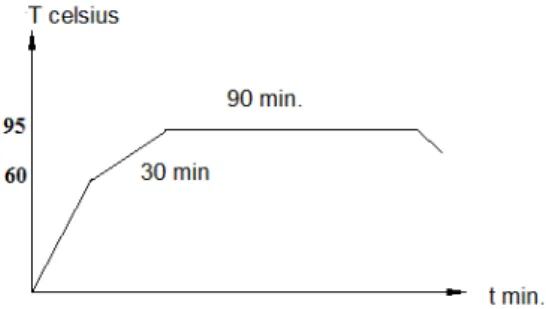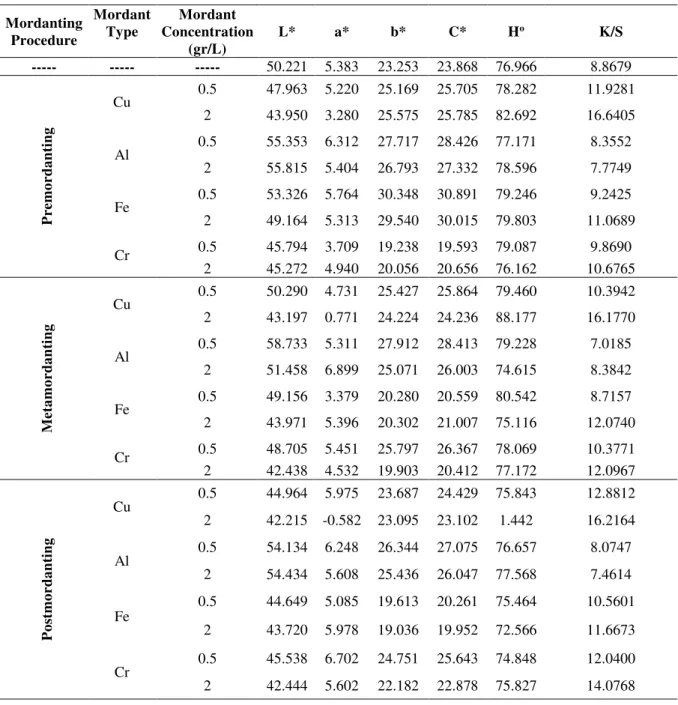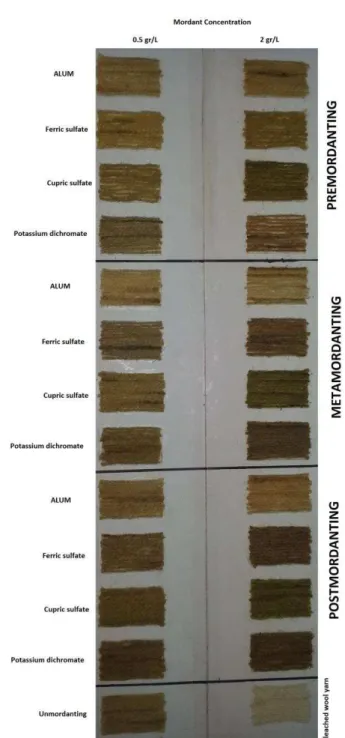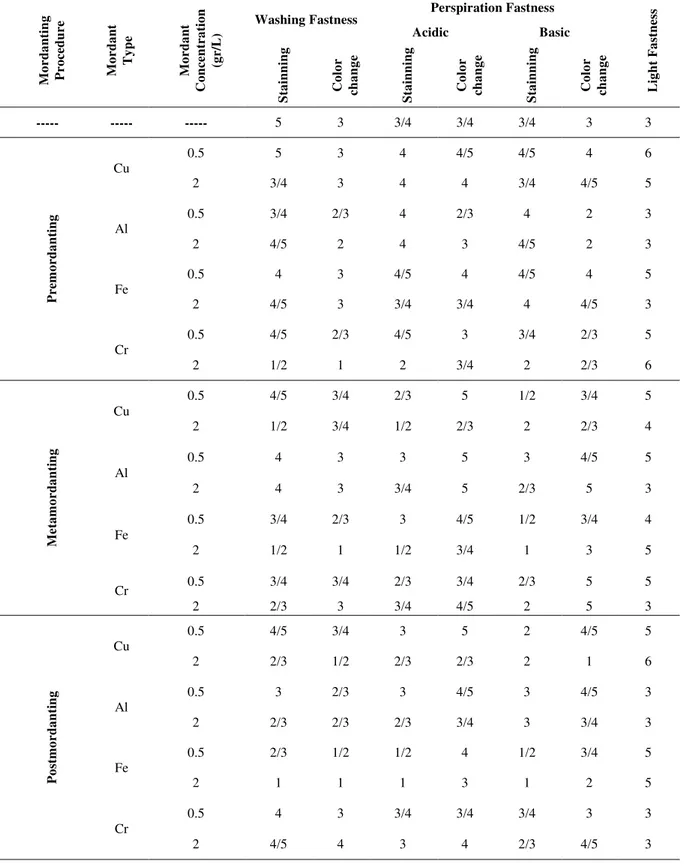53
DYEING OF WOOL YARNS WITH
LAURUS NOBILIS
L. BERRIES
ERKAN Gökhan
1, YILMAZ Derya
11Dokuz Eylül University, Faculty of Engineering, Textile Engineering Department, Tınaztepe Campus Buca, 35397 İzmir, TURKEY, gokhan.erkan@deu.edu.tr
Corresponding author: Erkan, Gökhan, gokhan.erkan@deu.edu.tr
Abstract: Nowadays natural dyes have been attracted by many researchers and firms due to demands on sustainable and nontoxic products. In this study the mature berries of bay laurel (Laurus nobilis L.) were
collected from trees located Kuşadası Turkey. The berries dried at 25oC and % 20-25 relative humidity. Dried
berries milled and extracted with ethanol. Extracted dye was used. Three mordanting procedure (pre, meta and post mordanting) and two concentrations were applied to wool yarns. Cupric sulfate, ferric sulfate, potassium dichromate and alum was used as mordant Color strength and colorimetric values were measured by Konica-Minolta 3600D spectrophotometer. Fastness to washing, perspiration and light were applied according to ISO 105C06 (A1S), ISO 105E04 and ISO 105B02 (method 2) respectively. The highest color strength (K/S) value was 16.6405 and was obtained in the case of premordanting with cupric sulfate at 2 gr/L concentration. If the a* and b* values were examined, the conditions at highest color strength, the yarns had yellow color with a reddish hue. Generally, the fastness properties were moderate and good results were obtained in the case of premordanting procedure. The results show us ethanol extract of bay laurel berries can be used for dyeing of woolen products.
Key words : natural dyes, mordanting, bay laurel, colorimetry, fastness
1.
INTRODUCTION
The history of natural dyes is as old as the history of humankind. Natural dyes are obtained from renewable sources such as crops, insects and so forth, and they may decrease the dependence on petrochemical sources [1]. These considerations have led to the publication of several studies on natural dyes from a number of sources [2–6]. Compounds present in extracts obtained from the most widely used natural dyes belong to a few main classes: flavonoids, anthraquinoids, indigoids and tannins [7]. Laurus Nobilis L. (bay laurel) is an aromatic evergreen small tree, native to the mediterranean area. Its berry is a drupe, oval shaped and the color of mature berries are black [8].
2. EXPERIMENTAL
2.1 Materials
54
Mature laurel berries were collected from trees located in Kuşadası, Turkey (at sea level,
latitude 37°44′ N and longitude 27°15′ E) during the lately October. The collected berries were dried in dark room. Dried berries were milled using coffe mill (Bosch).
2.2 Extraction
Extraction had been performed using ethanol at the liquor ratio of 3.9 (v/w) for 23 days. Extracted liquid was concentrated using rotary evaporator (IKA).
2.3 Mordanting
Figure 1 depicts the scheme for both mordanting and dyeing. Three mordanting procuders were applied premordanting, metamordanting, postmordanting. Rinsing was applied to yarns after mordanting using tap water. Two mordant concentrations were used, 0.5 and 2 gr/L. Liquor ratio was 1:15. Mordanting was performed using laboratory dyeing machine (ATAÇ-Turkey).
Fig 1:. Scheme of mordanting and dyeing
2.4 Dyeing
Dyeing was performed using laboratory dyeing machine (ATAÇ-Turkey). The liquor ratio was 1:15. Dyeing was carried out according to scheme in Figure 1. Washing off procedure after dyeing was 5 min. warm rinsing, two times of 5 min. duration involving cold rinsing.
2.5 Color measurment
All colour measurements were performed using Minolta 3600D spectrophotometer (D65 illuminant, specular included, 10o observer angle). The spectrophotometer was equipped with
software, which was able to calculate CIEL*a*b*C*h0 and colour strength (K/S) values from the
reflectance values at the appropriate λmax for each dyeing automatically. Color strengths of fabrics were determined by using the Kubelka– Munk formula (Eq. (1)), which is shown below.
K/S = (1-R)2/2R (1)
where K is the scattering coefficient, S is the absorption coefficient, R is the reflectance.
2.6 Fastness measurtments
55
3. RESULTS and DISCUSSION
3.1. Colorimetric values
The colorimetric values of dyed samples were listed in Table 1. When the effect of mordant type was examined, highest L* values were obtained mordanting with Alum. Type of mordanting procedure did not affect on L* values. The parameters that affect the L* values were mordant type and concentration. The lowest L* value was obtained in the case of postmordanting with 2 gr/L cupric sulfate. Highest vividness (C*) was obtained by premordanting with 0.5 gr/L ferric sulfate. a* and b* values were compatible with the colors that obtained, which are shown in Figure2.
Table 1: Colorimetric Values of Dyed Yarns
Mordanting Procedure
Mordant Type
Mordant Concentration
(gr/L)
L* a* b* C* Ho K/S
--- --- --- 50.221 5.383 23.253 23.868 76.966 8.8679
P
re
mo
rda
nting
Cu 0.5 47.963 5.220 25.169 25.705 78.282 11.9281
2 43.950 3.280 25.575 25.785 82.692 16.6405
Al 0.5 55.353 6.312 27.717 28.426 77.171 8.3552
2 55.815 5.404 26.793 27.332 78.596 7.7749
Fe 0.5 53.326 5.764 30.348 30.891 79.246 9.2425
2 49.164 5.313 29.540 30.015 79.803 11.0689
Cr 0.5 45.794 3.709 19.238 19.593 79.087 9.8690
2 45.272 4.940 20.056 20.656 76.162 10.6765
M
et
a
mo
rda
nting
Cu 0.5 50.290 4.731 25.427 25.864 79.460 10.3942
2 43.197 0.771 24.224 24.236 88.177 16.1770
Al 0.5 58.733 5.311 27.912 28.413 79.228 7.0185
2 51.458 6.899 25.071 26.003 74.615 8.3842
Fe 0.5 49.156 3.379 20.280 20.559 80.542 8.7157
2 43.971 5.396 20.302 21.007 75.116 12.0740
Cr 0.5 48.705 5.451 25.797 26.367 78.069 10.3771
2 42.438 4.532 19.903 20.412 77.172 12.0967
P
o
st
mo
rda
nting
Cu 0.5 44.964 5.975 23.687 24.429 75.843 12.8812
2 42.215 -0.582 23.095 23.102 1.442 16.2164
Al 0.5 54.134 6.248 26.344 27.075 76.657 8.0747
2 54.434 5.608 25.436 26.047 77.568 7.4614
Fe 0.5 44.649 5.085 19.613 20.261 75.464 10.5601
2 43.720 5.978 19.036 19.952 72.566 11.6673
Cr 0.5 45.538 6.702 24.751 25.643 74.848 12.0400
56
Fig. 2: Colour Catalgue of Dyed Yarns
3.2. Color Strength
K/S values are listed in Table 1. Highest color strength was observed in the case of premordanting with 2 gr/L cupric sulfate. Altough mordanting procedure did not significiantly affect on K/S values, mordant type and concentrations had effect on color strength values
3.3. Fastness Properties
57
Table 2: Fastness Properties
Mo rd a n tin g Pro ce d u re Mo rd a n t Ty p e Mo rd a n t Co n ce n tr a tio n (g r/L)
Washing Fastness Perspiration Fastness
Lig h t F a stnes s
Acidic Basic
S ta in n in g Co lo r ch a n g e S ta in n in g Co lo r ch a n g e S ta in n in g Co lo r ch a n g e
--- --- --- 5 3 3/4 3/4 3/4 3 3
Pre m o rd a n tin g Cu
0.5 5 3 4 4/5 4/5 4 6
2 3/4 3 4 4 3/4 4/5 5
Al
0.5 3/4 2/3 4 2/3 4 2 3
2 4/5 2 4 3 4/5 2 3
Fe
0.5 4 3 4/5 4 4/5 4 5
2 4/5 3 3/4 3/4 4 4/5 3
Cr
0.5 4/5 2/3 4/5 3 3/4 2/3 5
2 1/2 1 2 3/4 2 2/3 6
Meta m o rd a n ti n g Cu
0.5 4/5 3/4 2/3 5 1/2 3/4 5
2 1/2 3/4 1/2 2/3 2 2/3 4
Al
0.5 4 3 3 5 3 4/5 5
2 4 3 3/4 5 2/3 5 3
Fe
0.5 3/4 2/3 3 4/5 1/2 3/4 4
2 1/2 1 1/2 3/4 1 3 5
Cr 0.5 3/4 3/4 2/3 3/4 2/3 5 5
2 2/3 3 3/4 4/5 2 5 3
Po stm o rd a n ti n g Cu
0.5 4/5 3/4 3 5 2 4/5 5
2 2/3 1/2 2/3 2/3 2 1 6
Al
0.5 3 2/3 3 4/5 3 4/5 3
2 2/3 2/3 2/3 3/4 3 3/4 3
Fe
0.5 2/3 1/2 1/2 4 1/2 3/4 5
2 1 1 1 3 1 2 5
Cr
0.5 4 3 3/4 3/4 3/4 3 3
58
Satisfactory results were obtained for light fastness; however wet fastness were poor. There are no correlation fastness results with mordanting procedure and type and concentration of mordants.
4. CONCLUSIONS
Bay laurel is an important plant in food and detergent industry. In this study the dyeing properties of mature berries were investigated. Satisfactory dyeing results were obtained. Highest color strength was observed in the case of premordanting with 2 gr/L cupric sulfate. The highest L* values were obtained mordanting with Alum. Vividness of yarns increased with premordanting of wool yarns. However wet fastness results were not satisfied. Light fastness of yarns were moderate.
ACKNOWLEDGEMENT
The authors would like to thank Mr. Cem Özer for his assitance.
REFERENCES
[1] O. Deveoglu, G. Erkan, E. Torgan, R. Karadağ, “The evaluation of procedures for
dyeing silk with buckthorn and walloon oak on the basis of colour changes and fastness characteristics,” Color. Technol., vol. 129, 223–231, 2013.
[2] G. Erkan, K. Şengül, S. Kaya, “A Research on Dyeing of Denim Fabrics with Rubia Tinctorum L. (Madder),” Tekstil ve Mühendis (Journal of Textile and Engineers), vol. 17, 1-10, 2010.
[3] G. Gedik, O. Avinc, A. Yavas and O. Celik, “Cationized natural dyeing of cotton fabrics with corn poppy (papaver rhoeas) and ınvestigation of antibacterial activity,”, Asian J. Chem., vol. 25, 8475-8483, 2013.
[4] G. Gedik, O. Avinc, A. Yavas and Akbar Khoddami, “A novel eco-friendly colorant and dyeing method for poly(ethylene terephthalate) substrate,” Fiber Polym., vol.15, 261-272, 2014.
[5] R. Karadağ, E. Torgan, G. Erkan, “Dyeing Properties and Analysis by Rp-Hplc-Dad of Silk Fabrics Dyed with Madder (Rubia tinctorum L.),” J. Textile Sci. Eng., vol. 4, 2014
[6] T. Bechtold, A. Turcanu, E. Ganglberger, S. Geissler, “Dyes in modern textile dye-houses – how to combine experiences of two centuries to meet demands of the future?,” J. Clean. Prod. vol. 11, 499–509, 2003.
[7] O. Deveoglu, G. Erkan, E. Torgan, R. Karadağ, “The characterisation by liquid
chromatography of lake pigments prepared from European buckthorn (Rhamnus cathartica L.),” J.
Liq. Chrom. Relat. Technol., vol. 35, 331-338, 2012.
[8] E. Konstantinidou, I. Takos, T. Merou, “Desiccation and storage behavior of bay laurel



